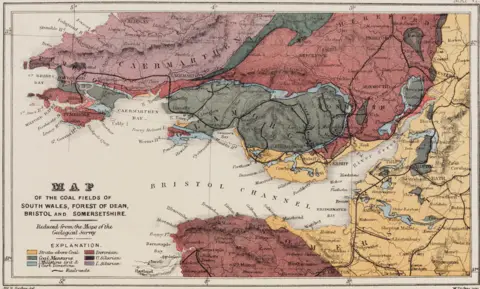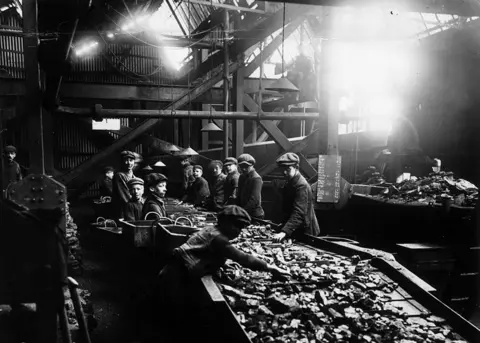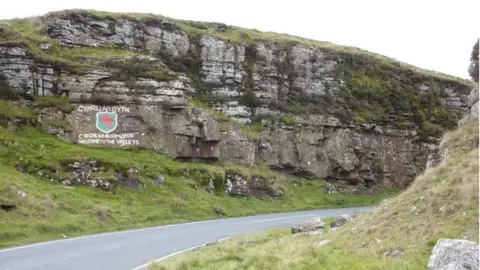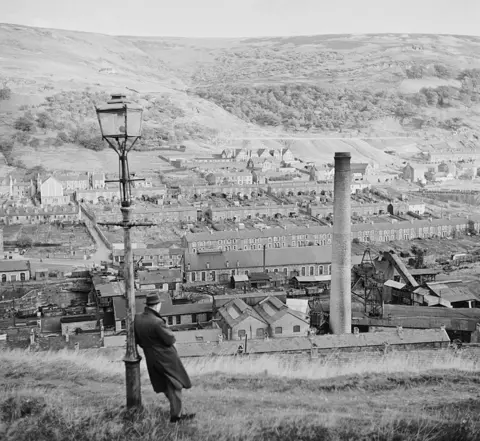'Without coal Wales would be part of England'
 Getty Images
Getty ImagesCardiff and Swansea are small villages, Wales has no capital and is considered a part of England like Cornwall.
A strange vision - but this is how some historians think Wales might have looked like if coal had not been discovered.
During the boom era between 1801 and 1901, Cardiff's population rose from 6,000 to 172,000 and Wales' from 587,000 to more than two million.
"More importantly, I wouldn't even have existed (without coal)," said Ceri Thompson from National Museum Wales.
With most mines closing 30 years ago, young people have no memory of them, yet many families are only here now because of their employment.
 Science & Society Picture Library/Getty Impahes
Science & Society Picture Library/Getty Impahes"Before the 19th Century and iron and coal were fully developed, each of the 13 counties of Wales had a fairly similar population," Mr Thompson said.
"By the end of the 19th Century, 66% lived in (the old) Glamorgan, Monmouthshire and Carmarthenshire, with a large population also growing around Wrexham."
During this period, he added, Wales was attracting as many new arrivals as the USA.
 Topical Press/Hulton Archive
Topical Press/Hulton ArchiveCoal exporting docks were built in Cardiff in 1830 and by 1881 it had overtaken Swansea and Merthyr Tydfil as Wales' biggest town.
"By 1921 there were 271,000 people in Wales directly involved in the coal industry alone," he said.
"There was also a huge number of others involved in retail, transport, farming (to feed the population), sheep farmers to clothe them, horse breeders to supply colliery horses, north Wales quarry workers to roof their houses and so on."
The Rhondda also changed beyond all recognition - in 1830, there were 900 people in both valleys, rising to more than 100,000 by 1900.
 Ivan Hall/ Geograph
Ivan Hall/ Geograph"The south Wales valleys would have had a scattered hill farming population (without coal)," Mr Thompson added.
"Cardiff, Swansea and Newport would have been small villages and wouldn't have developed into docks.
"There would probably be no capital of Wales, no National Library and no National Museum."
And in terms of where it fitted into the UK, it would "probably have been regarded the same way Cornwall is - a part of England", he said.
Mr Thompson compared the situation in Wales to its neighbour Ireland, which was experiencing a similarly dramatic population shift.
However, it was in the opposite direction - from eight million in 1841 to four million in 1921.
 Graphic House/Getty Images
Graphic House/Getty ImagesIreland was hit hard by famine between 1845 and 1851, with one million people dying of starvation and disease, and another two million leaving, a lack of industry also a contributing factor.
'Radically different'
"Wales would be a rural society with everywhere looking much like Gwynedd or Ceredigion do today," Prof Martin Johnes said.
"Our cities would be small rural towns."
The Swansea University historian said while any counterfactual history involves "a huge degree of speculation", he believes Wales would be "radically different".
He also said the Welsh language would be "much stronger" in south Wales, because English-speakers would not have moved in such huge numbers.
"The strength of the language would have meant Welsh identity survived without the prosperity generated by coal but it would have been an identity that always worried about its economic foundations," he added.
"In more recent years in this fictional Wales, relatively cheap housing and beautiful scenery would be attracting incomers from England creating fears around the impact of holiday homes and the vitality of Welsh in places like the valleys."
 Fox Photos
Fox PhotosEven steelworks at Port Talbot and Ebbw Vale, tin in Llanelli and copper in Swansea would not have been possible without coal, according to social historian Ben Curtis.
"Although charcoal had been used in the very early stages of the development of the iron and copper industries, their development as the major, defining, industries that kick-started the Industrial Revolution and thereby shaped modern south Wales would not have been feasible without the massive coal reserves of the south Wales coalfield," he believes.
He added: "If you're imagining a hypothetical scenario in which there were no coal deposits in south Wales, it's difficult to see what if anything could or would have led to the development of the region as a heavily industry one to any significant degree."